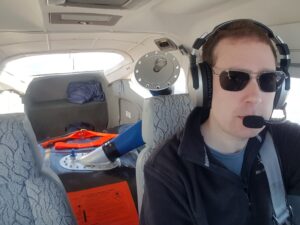
Earlier this month, Ross Edmondson departed for the first leg of a yearlong adventure that will take him around the world in a Cessna 182. After waiting more than two decades to make the journey, he finally made his plans official last year.
Ross was first inspired to become a pilot after spending a lot of time in flight simulators. In 2005, he earned his Private Pilot certificate in Florida. Then, in 2010, he proceeded to get his instrument rating and commercial certificate while studying with Gleim Aviation. Although he became familiar with a cockpit, he said his flight sim training helped accelerate his learning.
Ross has ties to Pittsburgh, Pennsylvania, and works internationally as a natural gas engineer. His schedule consists of 28 days working long hours in Iraq followed by 28 days off. This sparked an idea to do an around the world journey in six separate month-long legs, allowing him to enjoy and soak up as many sights as possible along his route during his time off. Ross will leave his plane at the last destination of each leg, fly commercially back to his job, and then return to pick up for the next leg. His trip required immense pre-planning, airplane modifications, and emergency preparedness. We caught up with Ross on the phone just before he left for his first leg to get all the details.
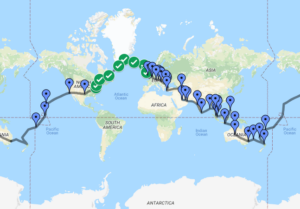
Q: What type of experience did you have flying long distances before you decided to go around the world?
Back in 2009, I started planning in earnest a trip around the world in a Cessna 182 that one of my friends initiated. We got fairly far in the planning process before she decided not to go. Since she was the aircraft owner, the trip was off, but the experience proved really helpful in planning my current trip.
A few years ago, I flew a little a plane, a Maule, from Rotterdam (the Netherlands) down to Egypt. Several other pilots had planned to go, flying one way while I flew the other, but backed out because they decided it wasn’t possible in a small plane. I went anyway and flew both directions, telling them they missed a great view of the pyramids when I returned. Once I figure out something is reasonably feasible, I try not to back out.
Q: How did you plan and prepare for the trip?
The first piece that fell into place was finding the right aircraft. At the start of last year, I bought a 1981 Cessna 182 R Model with an upgraded “Super Eagle” engine, which provides an extra 30-35 horsepower compared to a normal engine. I added Flint internal auxiliary Tip tanks, providing an extra 23 gallons of fuel in the wings. Not long afterward, I started planning the trip route and making arrangements.
I spent two months of last year traveling around Alaska and Canada–about 150 hours total. I even flew to Eureka (a Canadian territory about 600 miles from the North Pole). I flew some of it solo and other parts with friends, so that gave me a lot of experience with the aircraft. It gave me an idea of what tweaks and upgrades I wanted to make before going around the world.
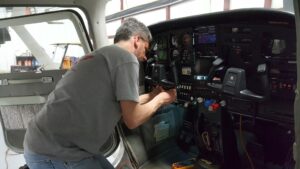
I put in the Garmin G5 attitude indicator and HSI (horizontal situation indicator) and removed the vacuum system (something that has failed on other people’s trips). I also switched out the old Garmin 430W GPS for an Avidyne 540. One of the most important tasks I did was putting on new tires and a new battery. The existing ones were OK for doing local flights, but they were getting a bit old. For 400 hours around the world, I decided not having new parts is not worth the risk.
One company, Mira Check (they have a checklist app for pilots), donated a pro account on the app as well as an iPad to run it on for the trip.
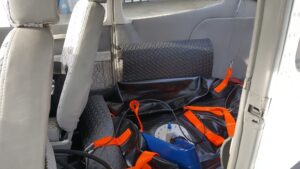
Another upgrade required for the longest leg of the journey–Hawaii to California–was additional fuel reserves. Normally, I have 88 gallons in the main tanks plus what’s in the Tip tanks. I had a Turtle-Pac fuel bladder professionally installed in the backseat area by a company in New Jersey, and all the controls are properly built into the panel. That allows another 150 gallons of fuel.
Q: What were the final steps taken for you to feel ready for departure?
About one month out, I worked with my mechanic to refresh everything on the aircraft and make sure everything was ready to go.
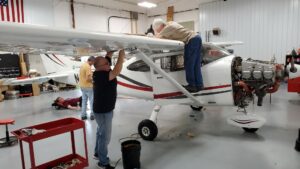
I also practiced for the longest leg of the flight by flying my aircraft fully weighted, with all the fuel and supplies aboard, from Daytona Beach to Los Angeles. This was a simulation of the real event, (minus being over open ocean, of course) as it is about the same distance as Hawaii to California. Now I know how I will perform, how the fuel tank works, and how the plane will feel. [Fun fact: Ross said his auto-pilot malfunctioned before he was out of Florida, so he flew the whole trip manually.]
“No matter what you try and prepare for, there will always be something that is unexpected.”
Q: Describe some of the planning challenges you encountered and how you resolved them.
First, the main stops in the Pacific no longer carry AVGas, so I had to find a company that would ship fuel out for me in barrels. Most people avoid this by going through Russia, Japan, or Alaska, but one of the highlights of the trip for me was going to be flying through the Pacific. So, with some professional help, I found a company to ship the fuel.
Next, when planning your routes, you have to stay on top of the political climate of other countries to ensure they are safe and available to fly over. Originally, I was looking to fly over Pakistan to get to India. Then, all air traffic in Pakistan shut down, so I’ve redirected for that section.
Finally, insurance was a very big challenge. It seems there are no insurance agencies in the U.S. anymore that will insure a small aircraft flying around the world. The only good option was $25,000 for the year. Since I’m still a UK resident (where Ross was born), I found UK coverage for about one-tenth the cost. If a pilot has the option, international insurance is the way to go right now.
Q: What type of preparation did you make for emergencies?
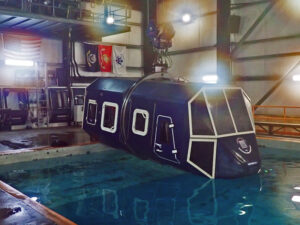
There’s a survival expert and pilot, Doug Ritter, who has written a lot about crash survival and has a great amount of information online. I’ve leaned heavily on him for information. He does aviation equipment reviews and publishes notes about what equipment you should have in case of emergency.
I also did two days of survival training in Connecticut with courses designed for anyone in small aircraft going over open water. Their simulator is modular and can be changed to match your aircraft, so the doors and seatbelts were swapped to match my Cessna 182 model. My first day of training was mostly in the simulator simulating a water crash. On the second day of training, they actually took me out to Long Island Sound and threw me in the water to practice getting into the life raft and other survival techniques. I was expecting it to be good, but it far exceeded my expectations, and changed my thinking about how I would respond in emergency scenarios.
I’ve set up a little toolkit for the aircraft for things like changing tires, doing oil changes–the owner-allowed maintenance side of things. In terms of spare parts, I’m trying to take only the minimum: cotter pins for changing tires, a few extra oil filters, spark plugs, and a few other items. I have a fairly comprehensive section of survival gear: life raft, life vest, a survival suit for cold water, etc.
On my person, I have a collection of survival gear I absolutely can’t do without. Things like my PLB (personal locator beacon), satellite communicator, a little bit of water, and some boiled sweets for energy. A couple of spare flares and rescue streamers and some sea dye are in the life vest. Then I have a “grab bag” for ditching and surviving a situation–some extra water and food, a signal mirror, a safety flare, and marine and air-band radios. The exact contents of the survival kit in the grab bag will vary depending on the leg of my trip, with the non-essential items stored elsewhere in the aircraft.
Q: What tips can you share with other pilots interested in flying around the world?
1) Anyone who wants to do this type of trip should first do a few shorter international flights. It really is all about the bureaucracy and logistics for this type of flight! Fly in Mexico, the Bahamas, and Canada to get an idea of what’s involved.
2) Find a good flight clearance company. For a lot of the countries you fly through, the company can organize the permits for you and organize handlers on the ground to meet you when you land. I am using General Aviation Support Egypt (G.A.S.E.). I’ve worked with them on a few flights before, and they handle a lot of international and around-the-world flights.
3) Talk to anyone you can who’s already done it. Even though not many people have flown around the world, enough have that there’s very little that has not been encountered. There’s a website called Earthrounders, which is a repository of information from people who have flown around the world. I’ve spoken to a lot of people through that website. What I’ve found in doing my kind of flying (slow, enjoying the places for a while) is that very, very few people seem to have done it that way. Most people are trying to break records or are flying with sponsors, and it’s a lot different from what I’m doing.
Some folks who have inspired me along the way are Barrington Irving, Robert Gannon, and Dr. Sophia Webster, an obstetrician I flew with who’s doing incredible work to reduce maternal mortality in Africa with help from aviation.
4) Over many years, I’ve discovered that everything will take longer than you think! Even when you think it will take a long time, it will take longer.
For example, during a trip from Cameroon, we kept getting shuttled around for paperwork at different offices. By the time we had the clearance we needed, it was too late to leave, so we went back to the hotel and spent another night.
“The way I try and do these trips is I want to make it something I can enjoy rather than being stressed about time. If you’re worried about time, you can become distracted and stressed out, which are ultimately unsafe conditions to fly in.”
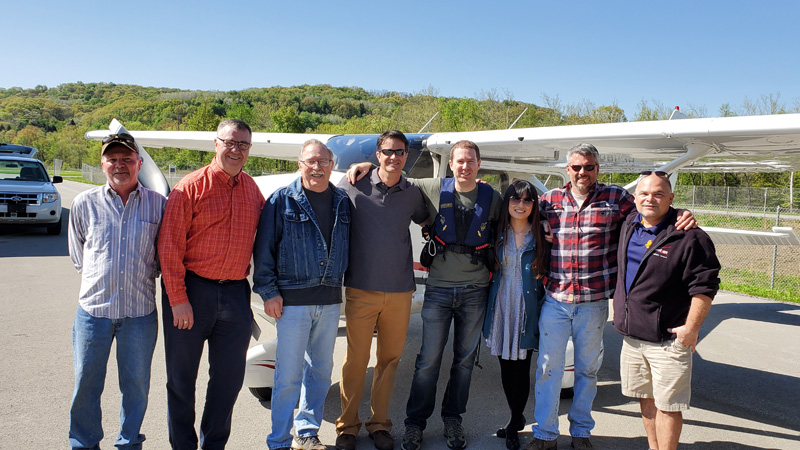
Q: What are some of the trip highlights you are most excited for?
I’ve tried to work in a lot more time than what I really need. Some of my stops are just a couple hours to refuel or an overnight. I’m hoping to spend two or more nights at other places that I want to explore. Some of the stops are strategically to places where I have friends and family that I want to visit. I’m half British and half Kiwi, and I haven’t been to New Zealand in over 10 years.
New Zealand is gonna be on the top of the list as far as highlights. Also, flying over the Pacific Ocean; the idea of crossing those enormous distances is really exciting.
Final Thoughts:
Ross’s flight is self-funded, and he is using this opportunity to raise awareness for a charity he is passionate about. Any money people donate will go directly to African Promise, a charity raising funds to enhance primary school education in Kenya. Visit this link to support the flight.
He has nearly completed the first leg of his trip, taking him from Pittsburgh, PA, through Canada, Greenland, and Iceland. He will continue through the UK, to Lelystad, the Netherlands, anticipated on May 29. You can read more detailed reviews of his preparation and trip details, not to mention follow along his trip in real time, on his website.
As soon as I started planning, I just kinda knew, “I’m going to make this happen.”

